Spider plants, a.k.a. Chlorophytum comosum, are among the most popular houseplants due to their attractive appearance and ease of care.
However, even the most well-cared-for spider plants can develop curled leaves. This “symptom” can indicate underlying issues.
Back in the days I used to wonder why were my spider plant leaves curling?
I searched a lot on this topic, and managed to find 11 most common causes of spider plant leaves curling and how to fix them.
In this article, I will provide preventative measures and tips for keeping your spider plants healthy. It’s essential to address the problem correctly to ensure the longevity of your plant and its optimal growth.
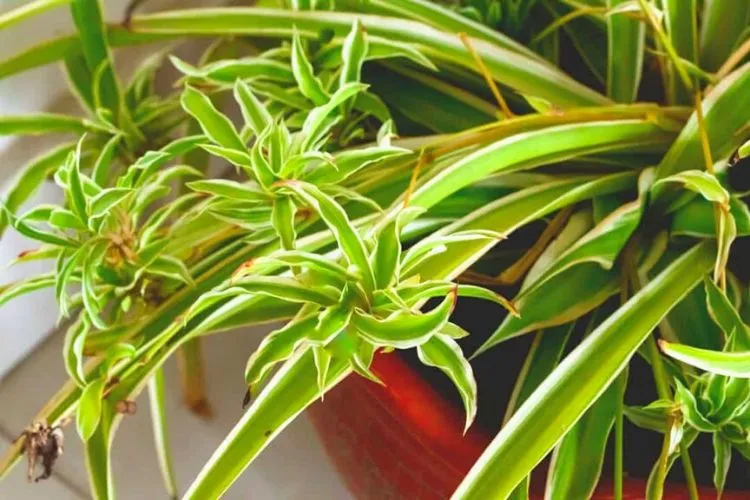
Table of Contents
11 Common causes of spider plant leave curling (With Fixes)
Spider plant leaves can curl for several reasons. They generally indicate underlying issues caused by specific stressors that usually require attention. Here are some of the most common causes of spider plant leaves curling and how to fix them:
Lack of Water or Overwatering
Lack of water
When a spider plant isn’t getting the right amount of water, it will develop curled leaves due to dehydration. The leaves may become limp and wilted, and the tips can start to dry out and/or turn brown. Without adequate water, the plant’s cells simply cannot function properly.
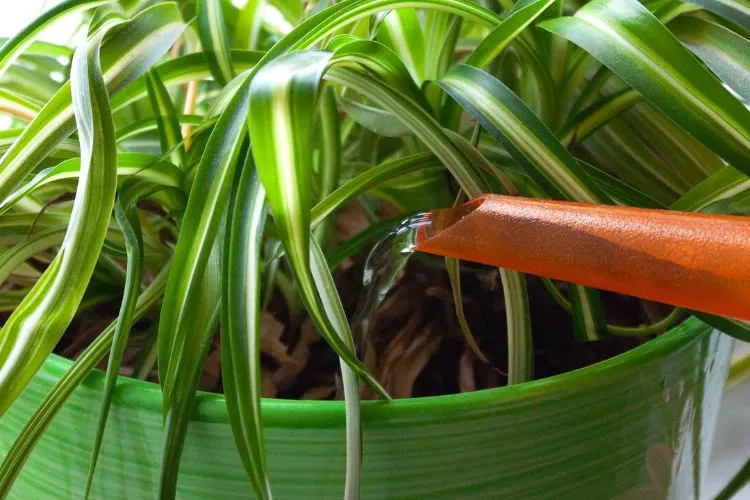
This leads to a loss of turgor pressure, which is the pressure that helps keep the plant upright, a.k.a. “Limping.”
Symptoms:
- Leaves become limp and wilted
- Leaf tips dry out or turn brown
- Lower leaves turn yellow or brown
- Curling leaves due to dehydration
Fixes:
- Only water when the top inch of soil feels a touch dry. This is usually once a week, depending on the plant’s environment and needs.
- Use a watering can with a narrow spout to deliver water directly to the soil and avoid wetting the leaves. Wet leaves encourage fungal growth, causing plant damage.
- If severely wilted, submerge the pot in a bucket of water for a few hours; this allows the soil to absorb moisture.
- If the plant seems to be drying out, water in gradual stages to prevent root damage caused by shock.
- Use a well-draining soil mix to prevent soggy roots and promote healthy root growth. Ensure the pot has adequate drainage holes to allow any excess water to escape.
Overwatering
An overwatered plant’s roots can suffer by becoming waterlogged. As a result, they simply cannot absorb enough oxygen. The water is so dense that the oxygen cannot penetrate and reach the roots. This leads to root rot, preventing the plant from absorbing nutrients and water effectively.
As a result, the plant will present symptoms such as curled and yellowing leaves. This usually indicates stress and possible damage to the root system.
Symptoms:
- Yellowing leaves
- Curled, droopy leaves
- Soft, mushy leaves
- Wilting or discolored leaves
- Root rot
- Moldy soil that stinks
Fixes:
- Ensure that the soil is slightly moist but not soggy.
- Only water when the top inch of soil is dry.
- Avoid watering too often or letting the soil dry out completely.
Low Humidity
Low humidity levels cause the leaves of a spider plant to become dry and curled. Spider plants generally prefer a moderate to high humidity level in their growing environment.
Low humidity can cause the plant to lose moisture through its leaves. As a result, issues such as dehydration and curled leaves can present themselves.
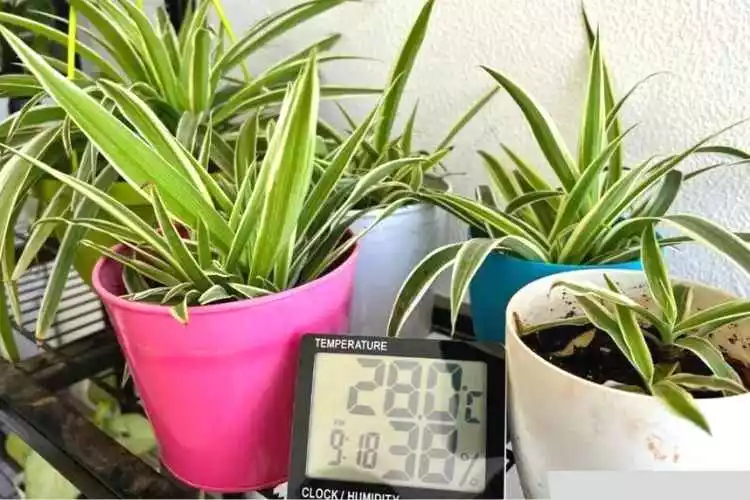
Symptoms:
- Dry, brittle leaves
- Curling, wrinkling of leaves
- Brown tips on leaves
- Slow growth and stunted development
Fixes:
- Increase humidity levels around the plant.
- Use a humidifier or place a tray of water near the plant.
- Mist the plants’ leaves.
Low-Quality Water
These plants are sensitive to certain minerals and chemicals that can often be found in tap water. As a result, the tips of their leaves may turn brown and curl.
Over time, this water source can lead to a buildup of salt and mineral deposits within the soil, affecting the plant’s overall health and presenting the mentioned symptoms.
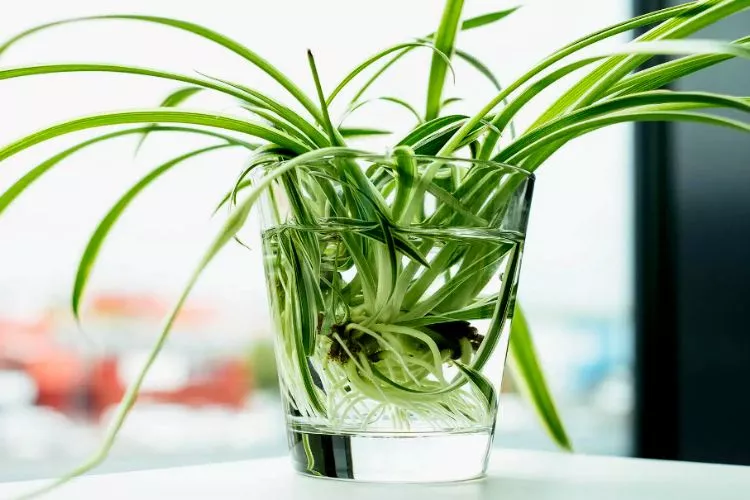
Symptoms:
- Leaf tips turning brown and curling
- Mineral deposits building up in the soil
- Slower growth and stunted development
Fixes:
- Use distilled or filtered water instead of tap water to avoid harmful minerals or chemicals.
- Allow tap water to sit for at least 24 hours before using it to water your spider plant.
Improper Soil pH Levels
Spider plants thrive best in soils with pH levels between 6.0 and 7.0. Too acidic or alkaline soil can affect the plant’s ability to absorb nutrients, leading to leaf curling and discoloration.
Symptoms of high pH levels of a spider plant:
- Brown or yellow leaves that can develop brown tips or edges
- Leaf curling
- Stunted growth and even new growth can slow down.
- Dry soil may require the plant to be watered more frequently than usual.
- More susceptible to pests and diseases.
Fixes:
- Check the pH using a pH tester kit.
- Lower the pH by adding an acidic soil amendment like elemental sulfur or aluminum sulfate. Follow the manufacturer’s instructions carefully when doing so.
- Water using distilled water or rainwater instead of tap water. Tap water can contain high levels of minerals that can increase the soil’s pH.
- Avoid using limestone or other alkaline amendments when fertilizing the plant.
- Repot the plant in fresh soil with the appropriate pH range to encourage healthy growth from planting.
Symptoms of low pH levels of a spider plant:
- Leaves turn yellow or brown and develop brown tips or edges.
- Slow growth may appear weak or stunted.
- More susceptible to pests and diseases.
- Dry soil – plants may require more frequent watering than usual.
Fixes:
- Check pH using a pH tester kit.
- Raise the pH by adding a soil amendment such as lime or wood ashes. Follow the manufacturer’s instructions when doing so.
- Water the plant with tap or well water. They may contain minerals that can help raise the soil’s pH.
- Use a balanced fertilizer to promote healthy growth and maintain the appropriate soil pH level.
- Repot the plant in fresh soil with the appropriate pH range to encourage healthy growth.
Root Rot
A combination of overwatering, poor drainage, and soil that remains wet for prolonged periods can lead to and amplify root rot. This condition causes the roots to decay, affecting the plant’s ability to absorb nutrients and water effectively.
If untreated, the rot will spread from the roots to the tip. As a result, spider plant leaves can curl and wilt, indicating stress and damage to the root system.
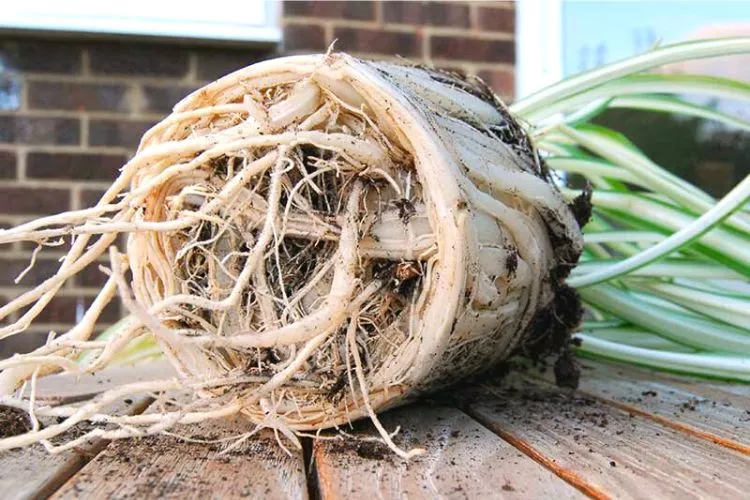
Symptoms:
- Curling, wilting of leaves
- Brown, mushy roots
- Stinky soil
- Discolored leaves
Fixes:
- Allow the soil to dry out slightly before watering.
- Check the roots for decay or rot and remove any affected areas.
- Repot the plant with fresh, well-draining soil.
Wrong Pot Size
A pot too small for a spider plant can cause the roots to become crowded and root-bound. As a result, there will be a lack of space for growth and development.
The plant will struggle to grow in the cramped space and exhibit curled leaves. This indicates stress and poor growth.
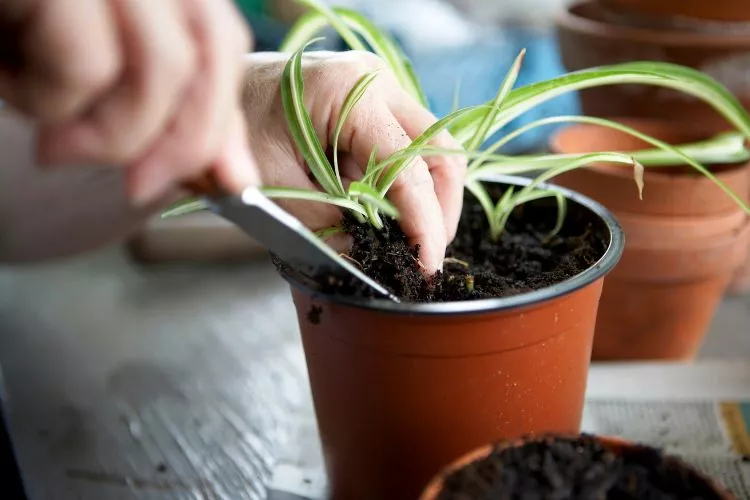
Symptoms:
- Stunted growth and development
- Root-bound plant
- Curling, yellowing of leaves
Fixes:
- Repot the plant in a slightly larger container.
- Ensure that the new pot has drainage holes to avoid waterlogging.
Exposure to Direct Sunlight or Drafts
Spider plants need bright, indirect light to survive. They should be kept away from direct sunlight and drafts. Exposure to these conditions can cause the leaves to dry out and become brittle. As a result, they will curl and fade in color.
Symptoms:
- Dry, brittle leaves
- Brown tips on leaves
- Curling, wrinkling of leaves
Fixes:
- Place the plant in a location with bright, indirect sunlight.
- Avoid placing it near air conditioning vents or drafty areas.
Nutrient Deficiency
All plants require some food source to enable them to grow and thrive. Spider plants are no different. These plants require a balanced supply of essential nutrients, including nitrogen, phosphorus, and potassium. These 3 play a strong role in growing and developing a plant properly.
In the case of a nitrogen deficiency, the leaves may appear yellow or pale green and curl or wilt. Nitrogen is essential for chlorophyll production, and its deficiency can lead to poor photosynthesis and growth.
Similarly, a potassium deficiency can cause the plant’s leaves to curl and turn yellow, while a lack of magnesium can lead to brown, curled leaf edges.
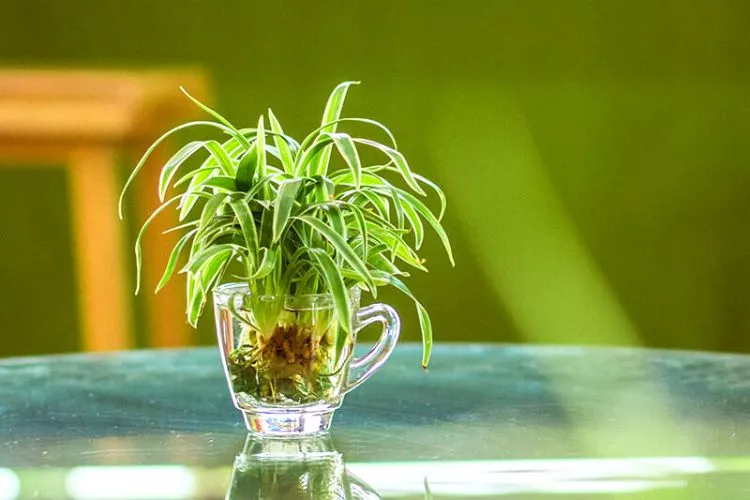
Both potassium and magnesium are important for plant metabolism, and their deficiency can affect various cellular functions.
Symptoms:
- Yellowing, curling of leaves
- Stunted growth and poor development
- Wilting, drooping leaves
Fixes:
- Use a balanced, water-soluble fertilizer for spider plants.
- Follow the manufacturer’s instructions for application.
Temperature Stress
Spider plants thrive in moderate temperatures that range between 55°F – 80°F (13°C – 27°C). Exposure to more extreme temperatures, such as cold drafts or hot, dry air, can cause plant stress and present leaf curling.
Symptoms:
- Curling, yellowing of leaves
- Stunted growth and poor development
- Wilting, drooping leaves
- Brown, dried-out tips on leaves
Fixes:
- Try to maintain temperatures between 55°F – 80°F (13°C – 27°C).
- Avoid exposing the plant to extreme temperatures, including fast fluctuations.
Pest Infestation
Spider plants can be affected by a few different species of pests. These include spider mites, mealybugs, and scale insects. All pest types can cause stress to the plant and affect its growth and development, causing curled leaves and other symptoms.
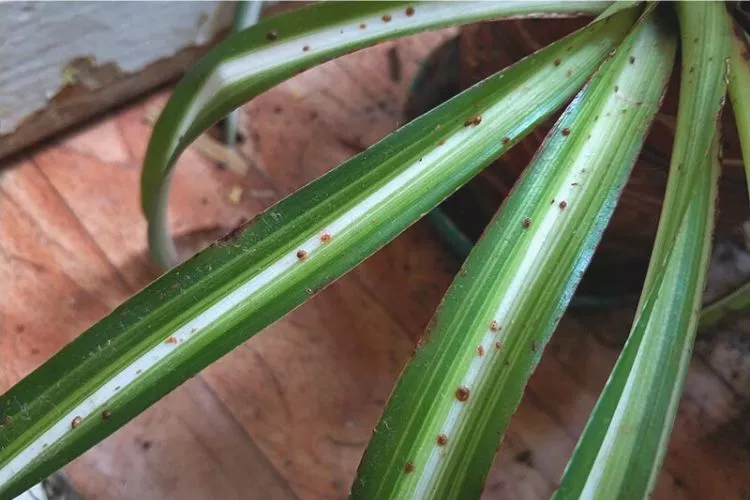
Symptoms:
- Leaves with tiny holes or yellow spots
- Webbing or cotton-like substance on the plant
- Curling and yellowing of leaves
Fixes:
- Identify the pest and treat it appropriately, such as with insecticidal soap or neem oil.
- Isolate the affected plant to prevent the spread of pests.
Bad Drainage
Proper drainage is one of the fundamental steps that must be addressed at the beginning of any plant’s growth journey. When water cannot drain properly, it can lead to waterlogging, root rot, and many other detrimental issues.
As a result, the plant may exhibit curled leaves, stunted growth, and other symptoms.
Symptoms:
- Wet, mushy soil
- Curling, wilting of leaves
- Slow growth and poor development
- Smelly soil
Fixes:
- Ensure the pot has adequate drainage holes to allow the water to drain freely.
- Use well-draining soil and avoid packing it too tightly.
Preventative measures
Spider plants are relatively low-maintenance, but that doesn’t mean they can’t suffer at the hands of poor management. Taking some simple steps can help to keep them healthy and prevent issues from occurring, such as curled leaves.
Let’s have a look at some tips you can apply to avoid curled leaves in spider plants:
Regular plant care routine
- Water spider plants once a week or when the top inch of soil is dry.
- Provide adequate light while avoiding direct sunlight.
- Avoid exposing the plant to temperature extremes or drafts.
- Fertilize spider plants every two to three months with a balanced NPK fertilizer.
- Keep the humidity level around the plant between 40% – 60%.
- Give your spider plant leaves a regular gentle dusting to allow them to absorb sunlight and air correctly. The dust can sometimes act as a blocker.
Monitoring plant health
- Regularly check spider plants for any signs of pest infestations, disease, or nutrient deficiencies.
- The early intervention addresses issues before they escalate and lead to curled leaves or other damage. The last thing you want is for your plant to dry due to mismanagement.
- Remove dead or decaying foliage to prevent the spread of unwanted disease.
Repotting
- Report spider plants at least once every 1-2 years to ensure proper growth and development.
- Choose a pot that is at least 1-2 inches larger in diameter than the current pot.
- Use a well-draining soil mix that includes coarse materials such as perlite and sand and organic material like peat moss.
- Carefully remove the plant from the current pot and gently untangle the roots.
- Trim off any dead or damaged roots.
- Place the plant in the new pot and fill it with soil, leaving enough space for watering.
- Water the plant thoroughly, and let it drain before returning it to its spot.
By following these preventative measures, you can keep your spider plant healthy and avoid curled leaves, ensuring a beautiful and thriving plant.
Pro tips for keeping spider plants healthy
Spider plants are easy to care for and make great additions to any indoor space. Here are some pro tips for overcoming the many common challenges in caring for spider plants as well as other useful care tips:
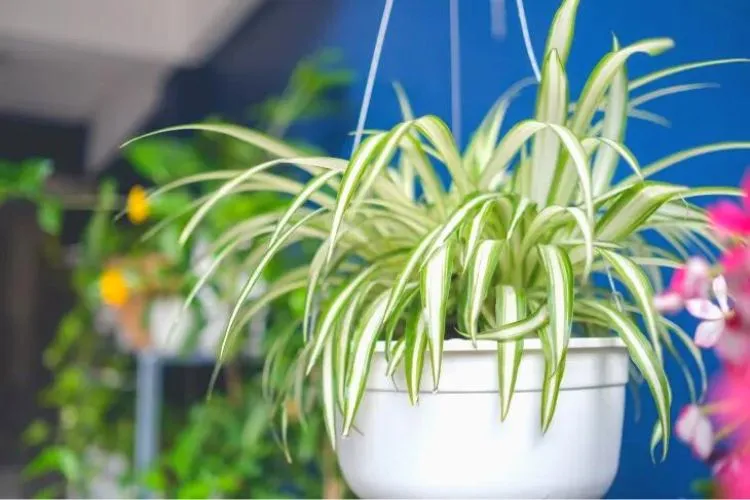
Overcoming common challenges
- If you’re struggling with overwatering, use a moisture meter to check the soil’s moisture level.
- When dealing with pest infestations, use organic pest control methods such as neem oil, insecticidal soap, or a mixture of water and dish soap.
- If low humidity becomes an issue, place a tray of pebbles and water under the plant, or use a humidifier.
Creative ways to display spider plants
There is a multitude of ways that a spider plant can be used for creative purposes. Here are some of the more common methods:
- Hang them in macramé plant hangers.
- Place them in a terrarium or a glass jar.
- Use them as a natural room divider or to create a green wall.
- Cluster them together in a group to make a bold room statement.
Other spider plant care hacks and tips
- Use rainwater or distilled water to avoid mineral buildup in the soil.
- Prune spider plants regularly to promote growth and prevent leggy plants.
- Use a balanced fertilizer every two to three months to ensure adequate nutrition.
- Propagate spider plants by placing the baby plantlets in soil or water until they root before transferring.
By incorporating these pro tips into your spider plant care routine, you can ensure your spider plant stays healthy and beautiful and avoid issues such as curled leaves.
Frequently Asked Questions (FAQs)
What does an overwatered Spider Plant look like?
An overwatered spider plant may have yellowing or drooping leaves. They may also present soft and mushy leaves as well as root rot. The plant may also have stinky soil.
Do spider plants clean the air?
Yes, spider plants are excellent air purifiers and remove toxins such as formaldehyde, benzene, and xylene from the air.
Do spider plants like bathrooms?
Spider plants thrive in areas with high humidity, making them ideal for bathrooms. However, they still need proper light and regular watering to avoid issues such as curled leaves.
Conclusion:
In conclusion, spider plants are low-maintenance and beautiful plants. However, issues such as curled leaves can arise due to various factors.
You can ensure that your spider plant remains healthy and vibrant by understanding the root causes and taking preventative measures, such as regular care routines, monitoring plant health, and proper repotting techniques.
We hope this guide has helped address your concerns about curling spider plant leaves. You can now take the necessary steps to keep your spider plant happy and thriving.


